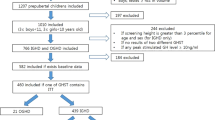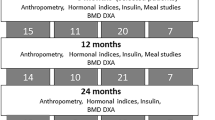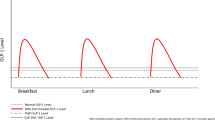Abstract
BACKGROUND: Obesity is characterised by growth hormone (GH) abnormalities, including a blunted response to stimulation and a ‘paradoxical’ increase after meals. The blunted GH release is reversed by a surgical intestinal bypass procedure. However, this does not mean that normal GH dynamics have been restored. The present study assessed whether post-surgical weight reduction in obese patients normalised the modulation of GH release produced by metabolic fuels.
SUBJECTS: Ten obese female subjects, aged 23–54 y, were studied before and after biliopancreatic diversion (BPD). All patients, after surgery, had experienced a significant reduction in body weight (mean body mass index (BMI) 25.78±1.01 kg/m2 vs 44.68±1.73 kg/m2). Two groups were also studied as controls: Ten normal body weight female subjects and ten patients suffering from anorexia nervosa (AN, mean BMI 17.46±1.12 kg/m2).
MEASUREMENTS: We have studied the GH response to a GH releasing hormone (GHRH) bolus (1 μg/kg iv, at 13.00 h) before and after a standard meal.
RESULTS: In post-BPD subjects, the GH response to GHRH in the fasting state, was clearly augmented in comparison with the pre-BPD values (peak values 18.06±4.56 vs 3.24±0.68 μg/L). In post-BPD subjects the postprandial GH response was further augmented in comparison with the fasting test (peak 30.12±4.99 μg/L, P<0.05). This pattern was similar to that observed in anorexic patients.
CONCLUSION: The surgical procedure restores a normal GH response to GHRH in the fasting state, but the ‘paradoxical’ GH response after meals remains present, suggesting a persistent GH derangement in such patients, which is not related to body weight per se. The surgical procedure makes obese patients similar to anorexics, in the relationships between metabolic fuels and GH secretion. The persistence of the GH postprandial response to GHRH in post-BPD subjects suggests a role for metabolic fuels in the regulation of somatostatin (SRIF) secretion.
This is a preview of subscription content, access via your institution
Access options
Subscribe to this journal
Receive 12 print issues and online access
$259.00 per year
only $21.58 per issue
Buy this article
- Purchase on Springer Link
- Instant access to full article PDF
Prices may be subject to local taxes which are calculated during checkout
Similar content being viewed by others
Author information
Authors and Affiliations
Rights and permissions
About this article
Cite this article
De Marinis, L., Mancini, A., Valle, D. et al. Evaluation of pre- and postprandial growth hormone (GH)-releasing hormone-induced GH response in subjects with persistent body weight normalisation after biliopancreatic diversion. Int J Obes 22, 1011–1018 (1998). https://doi.org/10.1038/sj.ijo.0800719
Received:
Revised:
Accepted:
Published:
Issue Date:
DOI: https://doi.org/10.1038/sj.ijo.0800719
Keywords
This article is cited by
-
Trends in insulin-like growth factor-1 levels after bariatric surgery: a systematic review and meta-analysis
International Journal of Obesity (2022)



